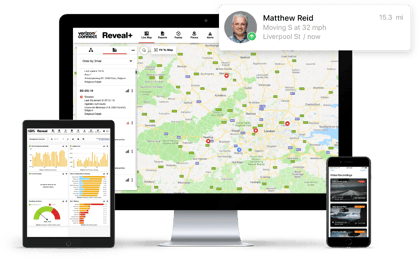9 Secrets to Reducing your Fleet Expenses
As a fleet owner, your day-to-day costs can quickly add up. What you don’t know is there are further hidden, expensive...
Read more
Monitoring driver hours and rest periods is crucial to successful fleet management. It not only helps to protect drivers and other road users from accidents, it also supports fleet managers in complying with European Tachograph regulations. The challenge here lies in gaining visibility over a fleet’s status, specifically accessing the near real-time status of tachograph information.
Fortunately, fleet management solutions can help companies to gain full visibility over driving time and rest periods.
Let’s take a look at what the rules and regulations on HGV driving hours are and how fleet tracking software can help you simplify compliance while improving operational efficiency.
According to the European Commission for Mobility and Transport, fatigue is a major factor in a large proportion of road crashes (10-20%). Specifically in the UK, there were 284 fatalities from accidents involving HGVs during 2016, which represents 16% of all road fatalities in that year. The conclusion from this is clear: tired drivers can present a significant risk to road safety. This also underlines how important it is for fleet managers to prioritise driver rest—for protecting their drivers and the public.
Keeping drivers safe and well rested is therefore one of the main motivations for the European tachograph regulations. The rules on HGV driver hours aim to thereby improve road safety and ensure good working conditions for drivers.
The UK is subject to Regulation (EC) No 561/2006, which sets rules on the maximum daily and fortnightly driving hours, as well as daily and weekly minimum rest periods. These apply to all drivers of road haulage and passenger transport vehicles, with some exceptions. Exceptions can also include a workforce agreement. The scope of operations under the regulations is quite broad, including both international and domestic driving hours, long and short distances, employees and self-employees.
According to the regulations, drivers must not drive more than:
Under the EU rules, drivers must:
All driving covered by these EU driver hours rules must be recorded on a tachograph. Compliance is subject to continuous monitoring, domestically and internationally, by checking tachograph records at the roadside and on-premises.
All driving covered by these EU driver hours rules must be recorded on a tachograph. Compliance is subject to continuous monitoring, domestically and internationally, by checking tachograph records at the roadside and on-premises.
Non-compliance with HGV driving hours rules normally involves either a tachograph offence (such as tampering with records) or a drivers’ hours offence. These offences were by far the most frequent type of infringement recorded by the Euro Contrôle Route (ECR) in 2017.
In the UK, lorry, bus and coach drivers who do not comply with the driving hours and rest regulations are subject to fines from the Driver and Vehicle Standards Agency (DVSA). DVSA can issue fines up to £300 each for up to five drivers’ hours offences committed within the last 28 days. That means a maximum fine of £1,500 in a single traffic stop. Depending on the offence, it may even lead to prosecution or immobilisation of the vehicle and cargo.
For fleet managers it’s clearly very important to avoid such heavy fines. Not keeping a close eye on driving time and rest periods can quickly impact the profitability of your operations.
GPS location and fleet management systems, combined with the digital tachograph from Verizon Connect can help fleet managers to access tachograph data and driver hours remotely. This helps you monitor your team’s driving hours and rest periods, thereby promoting road safety and helping to avoid errors that may lead to financial penalties, such as forgetting to insert the driver card.
Fleet management software is designed to give you better visibility of your entire fleet at all times, making it ideal for monitoring driving hours. It offers total and remote access to the driver's status, vehicle data, engine data and digital tachograph data at any time. You can even automate the remote download of the tachograph from the office, promoting the safety of your equipment and vehicles on the road. With easy access to this data at any time, without disrupting the driver, it also helps fleet managers assign new jobs within safe driving limits more effectively.
Implement a GPS solution for location and fleet management with digital tachograph. Doing so can help you to manage the regulatory compliance, security and operation of your fleet.
Tags: All




Find out how our platform gives you the visibility you need to get more done.
As a fleet owner, your day-to-day costs can quickly add up. What you don’t know is there are further hidden, expensive...
Read moreVerizon Connect Reveal tracks the fleet data that can have a big impact on your business. These are things like where...
Read moreAt Verizon Connect, we can only provide the highest possible level of service to fleet managers and business owners by...
Read moreReveal tracks the fleet data that can have a big impact on your business. These are things like where your vehicles are...
Read more